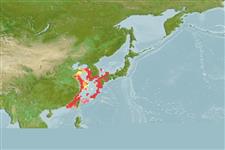>
Clupeiformes (Herrings) >
Dorosomatidae (Gizzard shads and sardinellas)
Etymology: Sardinella: Latin and Greek, sarda = sardine; name related to the island of Sardinia; diminutive (Ref. 45335).
More on author: Bleeker.
Environment: milieu / climate zone / depth range / distribution range
Οικολογία
Θαλασσινό(ά); ωκεανόδρομο(ς) (Ref. 51243); εύρος βάθους 5 - ? m (Ref. 12166). Subtropical; 38°N - 22°N, 117°E - 134°E (Ref. 54873)
Western Pacific: southern coasts of Japan south to about Taiwan.
Μέγεθος / Βάρος / Age
Maturity: Lm ? range ? - ? cm
Max length : 18.0 cm TL αρσενικό/απροσδιόριστο; (Ref. 56557); common length : 10.0 cm SL αρσενικό/απροσδιόριστο; (Ref. 188)
Ραχιαίες άκανθες (συνολικά): 0; Εδρικές άκανθες 0. Total scutes 29 to 32. Vertical striae on scales overlapping or continuous (discontinuous in S. fimbriata and S. albella), only a few small perforations on hind part of scale. No dark spot at dorsal fin origin. Most closely resembles S. richardsoni, which has more gill rakers and has a slightly deeper body; S. hualiensis has black tips to dorsal and caudal fins.
Found near shore, including semi-enclosed sea areas, on sandy mud bottom (Ref. 11230). Forms schools in coastal waters. Used in Chinese medicine (Ref. 12166).
Whitehead, P.J.P., 1985. FAO Species Catalogue. Vol. 7. Clupeoid fishes of the world (suborder Clupeoidei). An annotated and illustrated catalogue of the herrings, sardines, pilchards, sprats, shads, anchovies and wolf-herrings. FAO Fish. Synop. 125(7/1):1-303. Rome: FAO. (Ref. 188)
IUCN Red List Status (Ref. 130435)
Threat to humans
Harmless
Human uses
αλιεία: πολύ εμπορικό
Περισσότερες πληροφορίες
ΑναφορέςΥδατοκαλλιέργειεςΠροφίλ υδατοκαλλιέργειαςΣτελέχοιΓενετικήElectrophoresesΚληρονομικότηταΑσθένειεςΜεταποίησηNutrientsMass conversion
ΣυνεργάτεςΦωτογραφίεςStamps, Coins Misc.ΉχοιΣιγκουατέραΤαχύτηταΚολυμβητικός ΤύποςΕπιφάνεια βραγχίωνOtolithsΕγκέφαλοιΌραση
Εργαλεία
Special reports
Download XML
Διαδικτυακές πηγές
Estimates based on models
Preferred temperature (Ref.
123201): 13 - 24.7, mean 19.7 °C (based on 72 cells).
Phylogenetic diversity index (Ref.
82804): PD
50 = 0.5000 [Uniqueness, from 0.5 = low to 2.0 = high].
Bayesian length-weight: a=0.01230 (0.00694 - 0.02182), b=3.06 (2.91 - 3.21), in cm total length, based on LWR estimates for this species & Genus-body shape (Ref.
93245).
Τροφικό Επίπεδο (Ref.
69278): 3.2 ±0.3 se; based on diet studies.
Generation time: 2.2 ( na - na) years. Estimated as median ln(3)/K based on 2
growth studies.
Ελαστικότητα (Ref.
120179): Υψηλό, ελάχιστος χρόνος για διπλασιασμό πληθυσμού < 15 μήνες (tm=1).
Fishing Vulnerability (Ref.
59153): Low vulnerability (22 of 100).
Climate Vulnerability (Ref.
125649): High vulnerability (63 of 100).
Nutrients (Ref.
124155): Calcium = 159 [86, 301] mg/100g; Iron = 1.78 [1.05, 3.19] mg/100g; Protein = 21.2 [20.2, 22.1] %; Omega3 = 0.475 [0.231, 0.905] g/100g; Selenium = 40.5 [21.3, 76.6] μg/100g; VitaminA = 22.7 [6.8, 75.7] μg/100g; Zinc = 0.796 [0.579, 1.188] mg/100g (wet weight);
